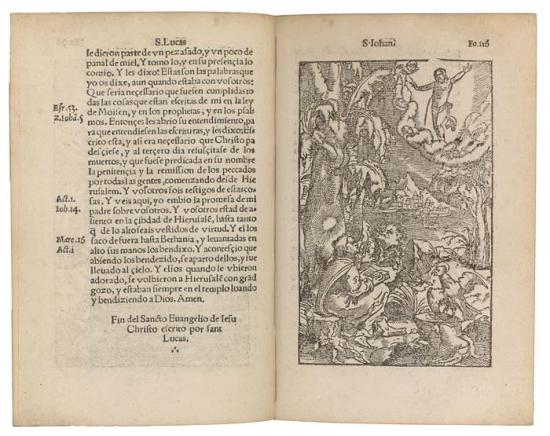
El nuevo testamento de nuestro Redemptor y Salvador Jesu Christo, traduzio de Griego en lengua Castellana
Antwerp: Stephen Mierdmann, 1543
Purchased in 1919
A STANDARD REFERENCE FOR SPANISH ARTISTS
The Church was one of the principal sources of artistic patronage in Spain. During the height of the Counter-Reformation, Spanish artists depicted primarily religious imagery: saints, gospel subjects, and scenes from the life of Christ and the Virgin Mary. This early Spanish translation of the New Testament, published in Antwerp, includes elaborate woodcut illustrations of the four Evangelists. The present opening represents St. John accompanied by his attribute, the eagle, seated in a landscape and experiencing a vision of Christ. Its distinctly Northern style recalls the internationalism of the arts in Spain.
From the sixteenth to nineteenth centuries, Spain witnessed the rise of the Catholic Church along with the flourishing of court artists who explored deeply spiritual visions. Concurrently, the nightmare of the Inquisition drove artists to probe the darker side of human nature through scenes of martyrdom and torture. Drawing played a central role in their conception of these diverse subjects—from Murillo's preparatory studies for painting commissions to Goya's private albums satirizing contemporary society. In addition to this rich tradition in Spain, Spanish artists also worked abroad, notably in Naples, which was a Spanish territory.
Visions and Nightmares marks the first exhibition of Spanish drawings at the Morgan, whose holdings in this area are small but significant. Showcasing over twenty sheets by Spanish artists spanning four centuries, this selection traces the shifting roles and attitudes toward the art of drawing in Spain.
This online exhibition was created in conjunction with the exhibition Visions and Nightmares: Four Centuries of Spanish Drawings, on view January 17 through May 11, 2014 and organized by Edward Payne, Moore Curatorial Fellow.
This exhibition is made possible by the A. Woodner Fund.
